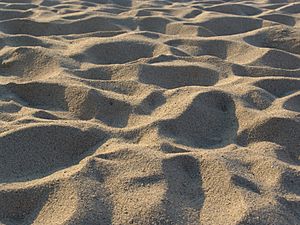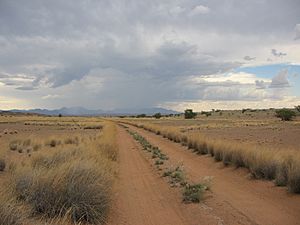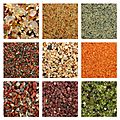Sand facts for kids

Sand is made of tiny pieces of different rocks and minerals. These small pieces come from larger rocks like granite and feldspar. Sand feels rough and gritty when you touch it. It forms naturally when big rocks break down into smaller and smaller bits.
This process is called weathering and erosion. Erosion happens when wind, water, or ice wear away rocks. Over a long time, large rocks turn into tiny particles. These tiny pieces then settle in places like beaches or deserts, forming sand.
Sand grains are bigger than silt but smaller than gravel. Silt grains are very tiny, while gravel pieces are much larger (from 2 millimeters to 64 millimeters). Most sand is found on beaches and in deserts. The most common type of sand is made of silica. Another common type is made of Calcium carbonate.
Sand dunes are hills of sand shaped by the wind or rivers. You can find them in deserts and sometimes on large beaches. Sand is also very important for making concrete. People also use sand to build fun sand castles. Sometimes, sand is even used in homes for decoration.
What is Sand Used For?
Sand has many important uses in our daily lives:
- Farming: Sandy soil is great for growing crops like watermelons, peaches, and peanuts. It also drains water well, which helps some types of farming.
- Aquariums: Sand is a good and cheap material for the bottom of fish tanks. It's especially needed for saltwater reef tanks, which try to copy ocean environments.
- Building Materials:
- Bricks: Sand is mixed with clay and other materials to make bricks.
- Concrete: Sand is a main part of concrete, which is a very important material for building.
- Glass: Sand that has a lot of silica is the main ingredient for making common types of glass.
- Mortar: Sand is mixed with cement to make mortar. This is used to hold bricks and stones together in buildings.
- Landscaping: Sand can be used to create small hills and slopes in gardens or on golf courses.
- Painting: Mixing sand with paint can give walls and ceilings a rough texture. It can also make floors less slippery.
- Railroads: Train drivers use sand to help the wheels grip the rails better. This is especially useful in bad weather.
- Fun and Play:
- Playing with sand is a favorite activity at the beach.
- Building sand castles is a popular beach pastime. These structures are known for not lasting very long!
- Many playgrounds have special areas called sandboxes for children to play in.
- Sand dunes are popular for climbing, riding motorcycles, and driving beach buggys.
- Road Safety: Sand is spread on icy or snowy roads to make them safer for cars.
- Art:
- Sand Animation: Artists create pictures by drawing in sand. Filmmakers also use sand on glass to make animated movies.
- Sand Casting: This is a way to make metal objects. Wet sand is shaped into a mold, and then hot, melted metal is poured into it.
- Protection: Sandbags are bags filled with sand. They are used to protect against floods and even gunfire. They are cheap and easy to fill quickly in emergencies.
- Cleaning: Sandblasting uses sand as an abrasive material to clean, prepare, or polish surfaces.
- Water Filters: Sand is used in special filters to clean and purify water.
Images for kids
-
Sand dunes in the Idehan Ubari, Libya
-
Different types of sand: glass, dune, quartz, volcanic, coral, garnet, and olivine. These samples come from places like the Gobi Desert, Estonia, Hawaii, and the United States.
-
Dark, heavy minerals mixed in with lighter quartz sand on a beach in Chennai, India.
-
Sand from Coral Pink Sand Dunes State Park, Utah. The orange color comes from a coating of hematite on the quartz grains.
-
Sand from Pismo Beach, California. It's mostly made of quartz, chert, igneous rock, and pieces of shells.
-
A close-up of black volcanic sand from Perissa, Santorini, Greece.
-
A picture of sand grains taken with a scanning electron microscope.
-
Sand grains from the Western Desert, Egypt, that have small pits. These pits are caused by the sand being carried by the wind.
See also
 In Spanish: Arena para niños
In Spanish: Arena para niños











